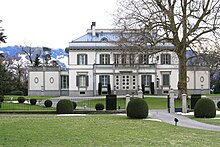Johann Jakob Staub
Johann Jakob Staub (born July 22, 1783 in Richterswil , Switzerland ; † January 29, 1852 in Paris ) was a famous Swiss master tailor in Paris.
Life
Staub was born in Richterswil on Lake Zurich in 1783 . In 1799, after his confirmation in Stäfa , he went rolling and initially worked in Lyon . He may have already made a modest fortune there as a self-employed tailor. Dust established himself in Paris between 1805 and 1810 . After the end of Napoleonic rule, the restoration led to the return of numerous noble refugees. This began a heyday for master tailors, and Staub became known as a successful Parisian “marchand tailleur”. In the twenties, his two houses on rue de la Victoire and rue de Richelieu employed over a hundred workers. Between 1825 and 1837, Staub changed his business address from one prominent location to another: 27 boulevard des Italiens, 1 rue de la Paix and finally 30 avenue de l'Opéra.
Honoré de Balzac calls Staub “le tailleur le plus célèbre de cette époque” (in “La Comédie Humaine, Illusions Perdues”). Dust is also mentioned in “ Les Misérables ” by Victor Hugo , in “Le Rouge et le Noir” by Stendhal , in “Le Vase Etrusque” by Prosper Mérimée and in “Les Diaboliques - A un dîner d'athées” by Jules Barbey d 'Aurevilly . In the “Thoughts” Heinrich Heine writes : “(In art) form is everything, matter is nothing; Dust charges the same price for the tailcoat, which he delivered without fabric, as if the cloth had been delivered to him. He only lets himself pay for the style and he gives the cloth as a present. "
Dust created the basis of his great fortune through tailoring, which he increased through cheap house purchases and financial transactions. In 1823 he bought a plot of land on the Meienberg ob Rapperswil on Lake Zurich , and in 1828 he built Meienberg Castle there , an elegant country estate in a classicist style. Staub and his family later combined additional properties on the Meienberg to form an extensive landscape park. In 1824, Staub married Joséphine Bourgeois. Staub was one of the patrons who made the building of the Reformed Church in Rapperswil possible. Staub's only daughter, Françoise Annette Staub, married Albert Braendlin , federal major and partner in the Brändlin spinning mill in Jona and on Uznaberg, in 1836 , who lived in Villa Grünstels not far from Staub's residence. Staub helped finance the expansion of the Braendlin spinning mills, which between 1832 and 1860 developed into the second largest group in the Swiss cotton industry.
literature
- Gottlieb Binder: On the cultural history of Lake Zurich. Erlenbach around 1936, p. 313 ff.
- Ernst Braendlin: Old stories from Meienberg, yearbook from Lake Zurich 1944/1945. Max Niehans, Zurich 1944, p. 103 ff.
- Jacques Hillairet: Dictionnaire Historique des Rues de Paris. (L / X). Les Éditions de Minuit, 1963/1997, p. 346.
- Eugen Halter and Liselotte Gass-Halter: The Meienberg near Rapperswil in the 19th century. 1984.
- Peter Röllin: Rapperswil-Jona culture construction kit. Rapperswil-Jona 2005, ISBN 3-033-00478-4 , p. 90 f.
| personal data | |
|---|---|
| SURNAME | Staub, Johann Jakob |
| BRIEF DESCRIPTION | Swiss master tailor in Paris |
| DATE OF BIRTH | July 22, 1783 |
| PLACE OF BIRTH | Richterswil , Switzerland |
| DATE OF DEATH | January 29, 1852 |
| Place of death | Paris |
